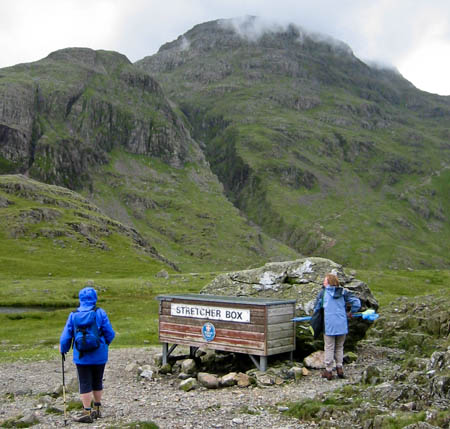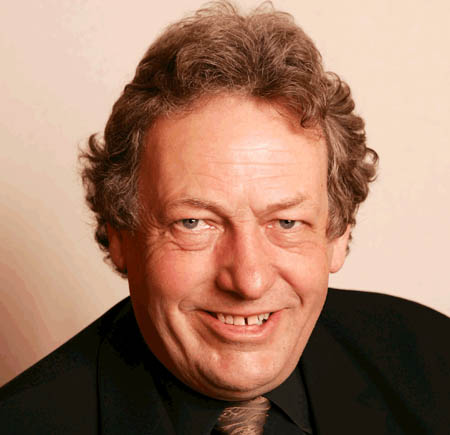
Sty Head, scene of a water rescue
Cumbria’s health chief today waded into the flood of comments swirling around the aborted Original Mountain Marathon last weekend.
Prof John Ashton, joint director of public health for the county council and Cumbria Primary Care Trust, said organisers of the OMM should pick up the bill for the rescue operation mounted during the two day event. 13 people were taken to hospital after the Borrowdale-based marathon, most suffering from minor injuries and mild hypothermia.
He also said the Government should consider giving weather warnings ‘legal status’.
Prof Ashton made his views known to the Cumbrian media and the BBC. He said the final cost of rescue operations was not yet known, but claimed it ‘will be enormous’. The public health director told the Westmorland Gazette: “In future, we need to look more closely at the responsibility of the organisers to work closely with the emergency services. It may be a case for government giving legal status to weather warnings and for individuals to insure themselves for the cost of rescue.”
Mountain rescue in the UK has always been provided free of charge by the volunteer teams and RAF mountain rescue teams which cover all of Britain’s uplands.
Further muddying the waters for outdoor activities, Prof Ashton said: “Considering all the weather warnings that were given should they now carry legal weight and should there be any legal liability for those ignoring advice given?”

Prof John Ashton
Prof Ashton’s views will add to the controversy started by Cumbria police who claim they warned OMM organisers not to go ahead with the event, and Honister Slate Mines owner Mark Weir, whose hyperbolic claim that the Lakeland fells were ‘within inches’ of being turned into morgues, was roundly ridiculed by most of the competitors, who were largely unaware of the media frenzy developing in the sodden valleys as they concentrated on staying on their feet and completing the event in, admittedly, some of the worst conditions it has ever been run in.
Mr Weir has been the subject of much debate on the OMM forums.
Prof Ashton said making organisers and participants stump up for rescue would enable costs to be recovered ‘the same way we do with road traffic accidents and events like the Great North Run’.
Quite how this would be determined when the vast majority of OMM participants neither needed nor asked for rescue has not been explained by the health director.
The OMM 2008 experience has been an object lesson in the inability of mainstream media to understand the ideals of extreme mountain events such as mountain marathons. Cumbria Constabulary has also come in for criticism. Organisers pointed out that one of the reason many competitors were ‘unaccounted for’ for so long was because police and staff from the slate mine were turning back runners and walkers at Honister Pass as they tried to reach the event HQ by road.
Organisers also claim that when they asked for the names of OMM-ers who had left after staying at the Cockermouth Sheep and Wool Centre, police said they had not recorded their details.
Ironically, the leader of one of the mountain rescue teams at the centre of the operation was himself taking part in the OMM. Mike Park, leader of the Cockermouth team, which covers Buttermere and Gatesgarth, the overnight campsite, defended the organisation of the marathon.
He told the News and Star: “I’ve got no beef about how they’ve organised the event, it was perfectly and adequately organised.
“If we start advising when and where they should or should not go then we are taking responsibility away from those individuals and we’re starting to wrap them up in cotton wool.”
Anyone wishing to contribute to the Lake Distict mountain rescue teams’ coffers can visit their Just Giving website. There is also an OMM-specific Just Giving site, started by participants which, at the time of writing, had raised £3,370
OMR
28 October 2008What a deeply ignorant man. I suppose we should all stay safe at home and be couch potatoes, just queuing up to fill his hospitals as we all keel over with heart diseases etc from obesity and lack of fitness.
At a time when people are being encouraged to take exercise, serious questions should be asked about this man's fitness to hold any position of authority in a health trust.
Fred
29 October 2008What is the general health status of those this shallow thinking lowland fool is in charge of?
What is he a Professor of - ill thought through sound bitism?
Nice hair do tho.
I hardly dare respond to his idiot suggestion - how will you charge for services that had already been been paid for.Who needed rescuing.What will you call the legislation - the anti - adventure bill? the clog up your arteries at home bill? T**t
Hope this doesn't sound abusive.
Ashley Cooper
29 October 2008I find it disapointing that a man with little or no knowledge of mountain rescue has so much to say on the subject. Mountain Rescue volunteers are happy and willing to provide their services for those in need, free of charge. The rubbish that has been spoken about this event by the media and comentators is unbelievable. Mark Weir from Honistor slate mine speaking on Radio 2's Jeremy Vine program on monday, did little more than spend his entire air time promoting his own business. If the media want sensible comments about mountain rescue stories they should come to the people who are involved in mountain rescue, not bit part players who know nothing about the subject. The utter rubbish talked about the cost of the rescue is unbelievable. MR teams give of their time for free, the RAF have to train so many hours a week and are usually glad of the free training that MR incidents provide and as for the police cost, it would probably be significantly less than policing your average saturday premiership football match.
Ashley Cooper
Team Chairman
Langdale Ambleside Mountain Rescue Team.
Bill Pattison M.B.E.
29 October 2008I agree with Ashley and attach no blame to the organisers .They did not force people to take part and every individual has a responsibility to decide if they want to enter,set off or turn back as appropriate.I know many of the competitors personally and would back their judgement against that of many chairbound critics who turned the event into a media circus.My main concern is with so many people taking part is the effect on footpaths which take a battering especially in bad weather.Bill Pattison M.B.E. Retired Team Leader ,Wasdale M.R.T.
Colin
29 October 2008Why oh why have so many public figures chosen to pipe up on this issue? Haven't they got really important jobs to be getting on with?
You can let John know what you think at this address: john.ashton@cumbriapct.nhs.uk
The Piglit
29 October 2008This man may be ignorant but he is in a position of power within health service delivery. This makes him IMHO more dangerous than anything (or anybody) on the fells.
And er.......just how much is the tax payer paying him in salary?
Rude not to enquire under the circumstances!
1,700 « blogpackinglight
30 October 2008[...] to justify their reporting ineptitude, the latest being that well known mountain marathon expert Prof John Ashton, joint director of public health for the county council and Cumbria Primary Care Trust, who is [...]
Ray Eagle
31 October 2008I sent the getleman a non-too friendly e-mail in which I also suggested that he did something about the appalling ill health of many inhabitants of Cumbria rather than seeking publicity for himself!
We, unfortunately, live in a world when many in situations of media; political; and public sector influence 'are not fit for purpose' to use that dreadful phrase.